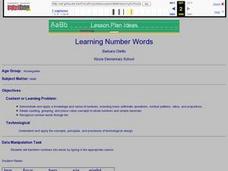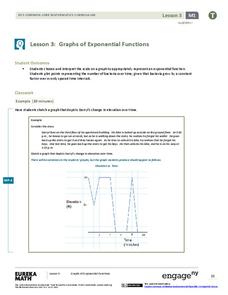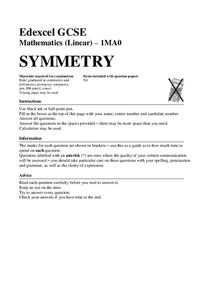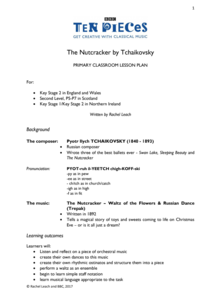Curated OER
Domain: Operations and Algebraic Thinking
Practice basic operations for young mathematicians in fun ways! Using two decks of cards (Ace through 10 plus the joker), learners play "memory" by matching numbers that can be added to make 10 and writing number sentences. In another...
Curated OER
Learning Number Words
Students practice saying their numbers and identifying the words. They use whole numbers and decimals to practice grouping numbers into different categories. They write the word of the number they are shown.
Curated OER
Counting Forward
Practice counting on from a number using these three sequence starters. Arranged in order of increasing difficulty, the first sequence begins at 5 and has learners add 9 numbers. The answers are written below each sequence, so they...
Curated OER
Skip Counting By Hundreds
There are 6 different number sequences for learners to complete. Each contains missing number. They skip count by hundreds to determine which number will best fill in the blank.
Curated OER
Mixed Math Millionaire: Math Game
Play a game to review a variety of math concepts. Factoring, square roots, number sequences, division, multiplication, order of operations, and word problems are all covered in this Millionaire style quiz game. Tip: Keep this resource as...
Curated OER
Pascal's Bats
In this number patterns activity, students look for patterns in the bats to help them write the numbers that would be on the 6th row of bats. Students write 2 different patterns they find.
Curated OER
Lesson 6: Mittens, Socks, Mittens, Socks, Mittens!
Mittens and socks, two of my favorite clothing items! Young learners with special needs, explore clothing appropriate for cold weather. They identify both socks and mittens, discuss weather appropriate clothing, and listen to the...
Curated OER
Hand Span and Height
Is there a relationship between hand span width and height? Statisticians survey each other by taking measurements of both. A table that can hold data for 24 individuals is printed onto the worksheet, along with questions for analysis....
Curated OER
Physical Setting: Physics Exam 2004
Twelve pages of mostly multiple-choice questions comprise this comprehensive New York Regents physics exam. It covers an entire year's worth of physics curriculum and requires about three hours for completion. Review the questions to...
EngageNY
Dividing by (x – a) and (x + a)
Patterns in math emerge from seemingly random places. Learners explore the patterns for factoring the sum and differences of perfect roots. Analyzing these patterns helps young mathematicians develop the polynomial identities.
College of the Canyons
Free Verse
Free verse poetry is often regarded as poetry without structure, but in reality, it is a poetic form that adheres to its own poet's thought and breath patterns. Delve into the rules and famous examples of free-verse poetry with a short...
EngageNY
Graphs of Exponential Functions
What does an exponential pattern look like in real life? After viewing a video of the population growth of bacteria, learners use the real-life scenario to collect data and graph the result. Their conclusion should be a new type of...
Illustrative Mathematics
Seven Circles III
A basic set-up leads to a surprisingly complex analysis in this variation on the question of surrounding a central circle with a ring of touching circles. Useful for putting trigonometric functions in a physical context, as well as...
Bowland
Patchwork Cushions
Find out if there are enough squares. Given diagrams for the first four figures in a sequence, pupils try to determine the next figure. Individuals find the number of square and triangle pieces of fabric that are required to make...
Code.org
Binary Numbers
All you need is a zero and a one. Build pupils' understanding of binary values and number systems to gain familiarity with binary numbers. Using a hands-on activity and technology, scholars learn how the binary system works and its...
Gatton Park
Magical Maths
A variety of activities take scholars outside the classroom to explore shapes, symmetry, measurement, patterns, sorting, and time in nature. Learners participate individually, and in teams, to measure found objects, go on a...
Mathed Up!
Symmetry
Eleven problems provide pupils the opportunity to find the lines of symmetry or identify rotational symmetry. Scholars alter designs to make them symmetrical, learn to recognize signs that are symmetrical, and identify the type of...
Curated OER
Compare and Contrast Essays
One of these things is not like the other. But, so what? Why is it important to examine the similarities and differences between two entities? Here's a presentation that shows viewers how to go beyond a mere listing to create and...
CK-12 Foundation
Recursive Formulas: Fibonacci Sequence
Explore the building blocks of the Fibonacci Sequence. Given the lengths of sides of squares, pupils deduce the pattern to determine the lengths of two more squares. Learners continue to work with recursive formulas to generate numerical...
BBC
The Nutcracker by Tchaikovsky
Over the course of six lessons, scholars try their hand at composing and dancing after a thorough examination of the famous ballet, The Nutcracker, by Tchaikovsky. Participants watch and discuss the performance of two dances, create...
Arcademics
Coconut Vowels
Scholars show what they know about vowel digraphs with a quick coconut-themed learning game. Players fill in the blanks of falling coconuts to make words with a double vowel spelling pattern.
K12 Reader
The Man Has a Can
Add this -an word resource into your plan for the day! Kids can read the poem, which includes several -an words to practice with, and then answer the three included reading comprehension questions.
Constitutional Rights Foundation
Driver’s Licenses And Unauthorized Immigrants
Should driver's licenses be granted to unauthorized immigrants? That is the question class members grapple with in a lesson that asks them to first read a fact sheet that details the arguments for and against licensing unauthorized...
EngageNY
When Can We Reverse a Transformation? 1
Wait, let's start over — teach your class how to return to the beginning. The first lesson looking at inverse matrices introduces the concept of being able to undo a matrix transformation. Learners work with matrices with a determinant...
Other popular searches
- Geometric Number Patterns
- Extending Number Patterns
- Fibonacci Number Patterns
- Math Number Patterns
- Number Patterns Worksheets
- Odd and Even Number Patterns
- Number Patterns in Math
- Ab Number Patterns
- Looking for Number Patterns
- Recognizing Number Patterns
- Number Patterns and Sequences
- Patterns Hundred Chart























